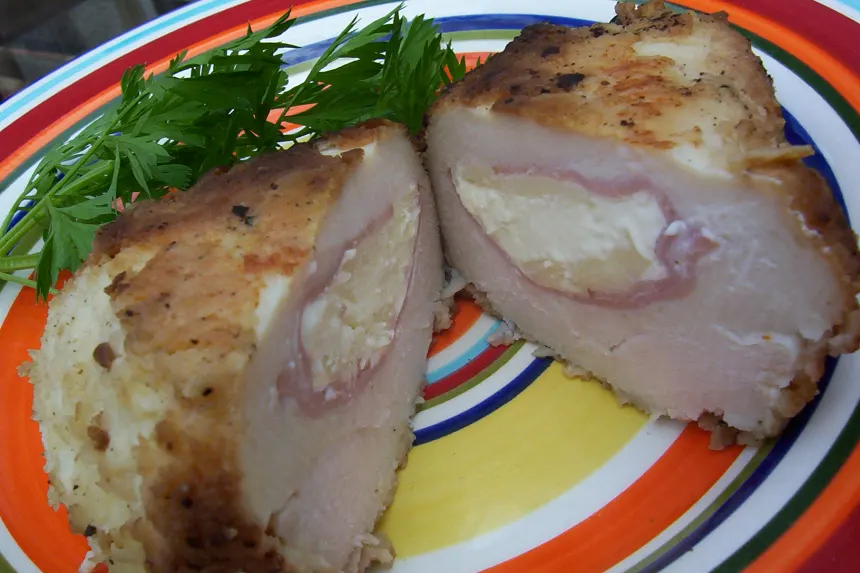You just found the best chicken cordon bleu recipe ever. Baked in the oven instead of fried, you don’t have to worry about any excess oil — or breaking out the deep fryer. Plus, I serve my cordon bleu chicken with a special homemade Dijon sauce instead of store-bought options.
Chicken cordon bleu is a classic dish that people love because the flavors and textures go so well together. One important thing that makes this dish work is cheese. But what cheese gives chicken cordon bleu its unique flavor? Let’s figure out what cordon bleu cheese is all about.
Swiss Cheese: The Traditional Choice
Traditionally, chicken cordon bleu is made with Swiss cheese. Swiss cheese is perfect for cordon bleu because it has a mild, slightly sweet flavor and melts very well. When ham and chicken are layered inside a golden, crispy breadcrumb crust, the nutty notes of Swiss cheese make the whole thing look beautiful.
Swiss cheese melts smoothly and evenly when heated, forming a luscious, gooey filling that binds the chicken and ham. This gives cordon bleu its signature soft, creamy interior encased within the crunchy exterior. The mildness of Swiss also allows the other flavors to shine through instead of overpowering them. Its subtle nuttiness adds depth without dominating.
The Origins of Chicken Cordon Bleu
The origins of chicken cordon bleu can be traced back to Switzerland in the 1940s. Chefs were making schnitzel stuffed with cheese, likely inspired by the French dish veal cordon bleu. After World War II, variations like chicken kiev became popular in America, especially among Russian and Ukrainian immigrants in New York.
The term “chicken cordon bleu” first appeared in print in a 1967 New York Times advertisement for United Airlines But the hallmarks of the dish – pounded, breaded chicken breasts stuffed with ham and cheese – were well established by then The name, meaning “blue ribbon” in French, evokes its refined, prestigious pedigree.
Alternatives to Swiss Cheese
Even though Swiss cheese is the best, you can use other kinds of cheese in chicken cordon bleu:
-
Gruyère – Similar to Swiss, with a bold, nutty flavor. Melts beautifully.
-
Emmental – Also comparable to Swiss, slightly milder than Gruyère
-
Provolone – Mild and tangy good melting properties. Go for a younger provolone.
-
Monterey Jack – Very mild, melts well. May need seasoning adjustments.
The important thing is to pick a cheese that has enough flavor, creaminess, and meltability. Strong flavored cheeses like gorgonzola are likely too overpowering. Brie and goat cheese are examples of soft cheeses that don’t melt well.
Stick with cheeses that emulate the nuttiness, smooth melting, and mildness of Swiss for best results. Experimentation can lead to new taste discoveries!
Handling and Preparing Cordon Bleu Cheese
Proper handling and preparation of the cheese ensures optimal flavor and performance:
-
Grate vs. pre-shredded – The anti-caking agents in pre-shredded cheese can prevent smooth melting. Freshly grated is best.
-
Amount of cheese – About 1-2 ounces per chicken breast provides sufficient richness without excess.
-
Melting – Cook at a moderate temperature so the cheese melts before the breading burns. Pound chicken evenly.
-
Mixing cheeses – Combining Swiss with small amounts of Gruyère or provolone adds complexity.
-
Assembling ahead – Cordon bleu can be assembled up to 24 hours before cooking, but bread just before cooking to maintain crispy texture.
Complementary Ingredients
While cheese might be the star, supporting players deserve attention:
-
Ham – Black Forest or honey ham are ideal choices. Their sweet, smoky flavors complement the cheese.
-
Chicken – Tender, pounded chicken breast lets the filling shine. Consider pounding between sheets of plastic wrap for uniform thickness.
-
Breading – A light, crunchy panko or seasoned breadcrumb coating provides textural contrast to the creamy interior.
-
Sauce – A creamy sauce, like a Dijon bechamel or wine-based pan sauce, balances the richness of the cheese.
Regional Twists
Like any global favorite, chicken cordon bleu enjoys some regional and cultural variations:
-
In Italy, cured prosciutto may be used instead of ham.
-
German versions might incorporate nutmeg and thyme into the breading.
-
Some French recipes stuff the chicken with rich triple crème brie alongside the ham.
-
In American cuisine, cheddar, pepper jack or other strongly flavored cheeses sometimes make an appearance.
No matter the interpretation, the winning combination of crispy chicken, savory ham, and melting cheese at the heart of chicken cordon bleu maintains its beloved status worldwide.
Serving Suggestions
There are many excellent ways to serve up crispy, cheesy cordon bleu:
-
Fresh green salad or roasted vegetables make ideal lighter pairings.
-
For heartier accompaniments, options include mashed potatoes, egg noodles, rice pilaf, or buttered pasta.
-
A creamy, mustard-spiked béchamel sauce or velvety mushroom gravy can be spooned over the top.
A sprinkle of chopped parsley adds a pop of color and freshness. Serve chicken cordon bleu hot out of the oven for the very best experience of flavors and textures in harmony.
Frequently Asked Questions
Let’s answer some common questions about making chicken cordon bleu:
Can I use mozzarella instead of Swiss cheese?
Mozzarella lacks the depth of flavor and melting quality of Swiss cheese. It’s too watery and bland. Opt for a more flavorful, nutty cheese.
What’s the best way to melt the cheese inside?
Cook at a moderate temperature to allow the cheese to melt gradually before the breading burns. Pound the chicken evenly for consistent cooking.
How much cheese should I use?
About 1-2 ounces of cheese per chicken breast provides sufficient richness. Adjust to your taste preferences.
What kind of ham works best?
Choose a subtly sweet ham like Black Forest or honey that pairs well with the cheese. Thin slices ensure even cooking.
Can I make it ahead of time?
Yes, assemble up to 24 hours before baking. Refrigerate until ready to cook. Bread right before baking to maintain crunch.
What sauce complements it well?
A Dijon mustard sauce or creamy béchamel complement without overpowering. A lemony butter sauce also pairs nicely.
An Elegant, Timeless Classic
Chicken cordon bleu has earned its place as a cherished staple of home cooks and restaurants alike. While interpretations abound, at its core, this dish celebrates the harmonious marriage of flavors and textures. The starring role played by melted cheese – classically Swiss – helps create the luscious, flavorful interior that defines this culinary masterpiece. s this iconic recipe endures, so too will the continually evolving art of the perfect chicken cordon bleu.

How to Store the Cordon Bleu Chicken
Store leftover chicken cordon bleu in an airtight container in the fridge after it has cooled completely. When properly stored, it will keep for up to 3-4 days.
To reheat, preheat your oven to 350 degrees F. Put the chicken cordon bleu in the oven for 10 to 15 minutes, or until it’s hot all the way through. Brush it with a little olive oil to keep it from drying out.

Best Chicken Cordon Bleu Recipe FAQs
The recipe for chicken cordon bleu is famous for its perfect blend of flavors and textures. It features tender chicken breast, savory and salty ham, and mild Swiss cheese and is breaded before it’s baked (or fried) to perfection.
People love it so much that April 4 is National Cordon Bleu Day, and a famous cooking school in Paris bears the name, too.
